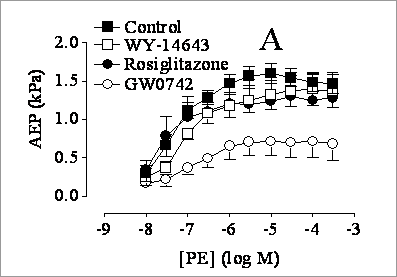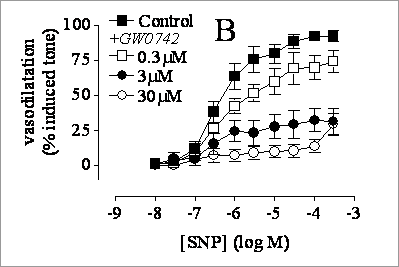PPARβ activation induces vascular hyporeactivity: comparison with other PPAR ligands Our understanding of the role of the nuclear receptor peroxisome proliferator-activated receptor beta (PPARβ ) is incomplete, although it has been associated with cardiovascular and inflammatory functions (Wahli, 2002). For example, PPARβ is expressed in the heart and can modulate inflammation (Lee et al., 2003). However, the effects of activation of PPARβ (or other PPAR receptors) in vasomotor responses in not known. Here we have addressed this question using rings of murine aorta in organ cultures. Male C57BLK6 mice (25-32g) were killed by exposure to CO2. Aortic rings were incubated in DMEM in the presence of PPAR ligands or vehicle for 48 h at 37 °C before being mounted in myographs. Vasoconstriction and vasodilatation (% reduction in pre-constricted tone, EC80 concentration of U46619) were determined as described previously (Harrington and Mitchell, 2004).
Figure (A) Contractile effects of phenylephrine (PE) in vessels pre-incubated (48 h) with vehicle (control) or with ligands to PPARα (WY-14643), PPARγ (rosiglitazone) or PPARβ (GW0742) (all 30 m M). (B) Effect of pre-incubation (48 h) with GW0742 (0.3-30µM) on vasodilator responses to sodium nitroprusside (SNP) in U46619 (EC80) contracted vessels. Data is mean ± s.e.m. for n=5 determinants. Incubation with PPARα or PPARγ ligands did not affect aortic contractility. However, incubation with the PPARβ ligand caused aortae to become hyporeactive to the contractile effects of phenylephrine (Figure 1A), although not to the contractile effects of U46619 (e-max; control vessels 1.36±0.24 kPa: plus GW0742, 1.34±0.25). GW0742 also greatly inhibited vasodilatations in response to SNP (Figure 1B). These data suggest that PPAR , but not PPARα or PPARγ , has an important modulatory role in the maintenance of vasomotor tone. Harrington, L. and Mitchell, J.A. (2004). Br J Pharmacol 143: 611-617. This work was funded by the Joint Research Board of St Bartholomew’s Hospital, London. |



